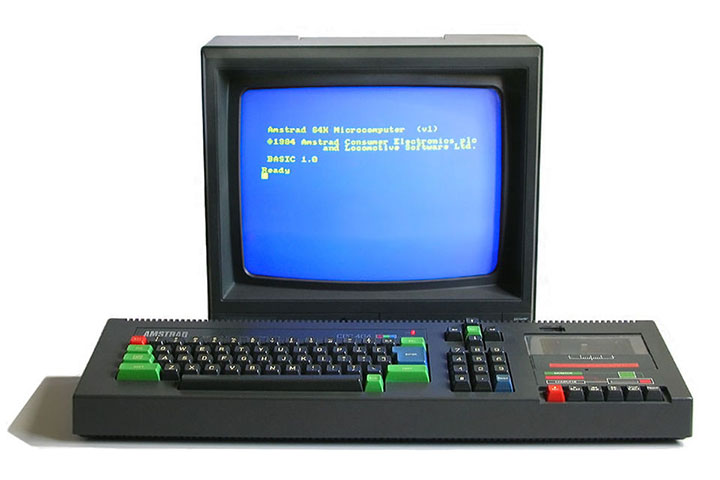The Amstrad CPC: A Deep Dive into a British 8-bit Icon
The Amstrad CPC (Colour Personal Computer) was a hugely popular 8-bit home computer released in the early 1980s, primarily in the UK, Spain, and Germany. It’s remembered fondly for its affordability, distinctive look, and a vibrant gaming scene. Here’s a comprehensive overview:
History & Development
- Amstrad’s Entry: Amstrad (Alan Sugar’s company) was primarily known for consumer electronics like hi-fi systems and tape recorders. They saw an opportunity in the burgeoning home computer market.
- Cost-Cutting Focus: Alan Sugar’s strategy was to undercut the competition (Commodore 64, ZX Spectrum) by focusing on cost-effective manufacturing. He achieved this by integrating components and using a single chip for many functions.
- Launch (1984): The CPC 464 was launched in June 1984, priced at £399 with a colour monitor and built-in cassette recorder – a significant advantage over rivals that often required these as separate purchases.
- Success & Models: The CPC quickly became a bestseller, challenging the dominance of Sinclair and Commodore. Several models followed:
- CPC 464 (1984): The original, with 64KB RAM, a Z80 processor, and a distinctive rubber keyboard.
- CPC 664 (1985): Added a floppy disk drive.
- CPC 6128 (1986): Increased RAM to 128KB, improved keyboard, and a more professional look. Considered the most desirable model by many enthusiasts.
- CPC Plus (1990): A minor revision with a slightly improved sound chip.
- GX4000 (1991): A games console based on the CPC Plus hardware, aimed at a more casual market.
Technical Specifications (CPC 464 as a base)
- Processor: Zilog Z80A running at 3.5 MHz
- RAM: 64KB (expandable to 128KB in later models)
- ROM: 16KB (containing the BASIC interpreter and operating system)
- Graphics:
- Resolution: 320 x 200 pixels
- Colors: 16 colors, with a limited number available per line. The CPC’s graphics were known for being bright and vibrant, but also had limitations in terms of color clash (where colors would bleed into each other).
- Sound: General Instrument AY-3-8912 sound chip, capable of 3 channels of sound plus noise. This chip was a significant strength, offering better sound quality than many competitors.
- Storage: Built-in cassette recorder (standard on the 464). Floppy disk drive optional (664, 6128).
- Keyboard: Rubber keyboard (464) or a more conventional keyboard (6128).
- Ports: Joystick ports, monitor port, cassette port, printer port, expansion port.
Strengths of the Amstrad CPC
- Affordability: The CPC was significantly cheaper than many of its rivals, making it accessible to a wider audience.
- Integrated Features: The inclusion of a colour monitor and cassette recorder in the base model was a major selling point.
- Excellent Sound: The AY-3-8912 sound chip provided superior sound quality compared to many other 8-bit machines.
- Good Graphics: While limited by color clash, the CPC’s graphics were bright and vibrant.
- Strong Gaming Library: The CPC attracted a dedicated following of game developers, resulting in a large and diverse library of games.
- BASIC Interpreter: A relatively easy-to-learn BASIC interpreter allowed users to create their own programs.
Weaknesses of the Amstrad CPC
- Rubber Keyboard (464): The original rubber keyboard was often criticized for being mushy and unresponsive.
- Color Clash: The limited number of colors available per line could lead to visual artifacts in some games.
- Limited Expansion: While expansion was possible, it wasn’t as flexible as some other systems.
- BASIC limitations: While usable, the BASIC interpreter wasn’t as powerful or feature-rich as those found on some other machines.
Games & Software
The Amstrad CPC had a thriving gaming scene. Some notable titles include:
- Head Over Heels: A groundbreaking isometric adventure game.
- Dizzy series: A popular series of puzzle-platformers.
- Barbarian: The Ultimate Warrior: A controversial but popular fighting game.
- Chase HQ: A fast-paced driving game.
- Roland in the Caves: A classic platformer.
- Batman: The Movie: A tie-in game based on the 1989 film.
- Arkanoid: A brick-breaking classic.
- Manic Miner/Jet Set Willy: Classic platformers ported from the ZX Spectrum.
Beyond games, the CPC also had software for:
- Word Processing: Wordsworth
- Database Management: Cactus
- Graphics: Various art packages.
- Education: A range of educational software.
Legacy & Emulation
- Cult Following: The Amstrad CPC retains a dedicated following of enthusiasts who continue to develop new software, preserve old games, and share their passion for the machine.
- Emulation: The CPC is widely emulated, allowing users to play its games on modern computers and devices. Popular emulators include:
- Caprice32: A highly accurate and feature-rich emulator.
- WinAPE: Another popular and well-regarded emulator.
- Hardware Recreations: There’s a growing interest in recreating the CPC hardware, with projects like the “FC CPC” aiming to build a modern, FPGA-based version of the machine.
Where to find more information
- CPC Wiki: https://cpcwiki.eu/ – A comprehensive resource for all things Amstrad CPC.
- Amstrad CPC Forum: https://amstrad.eu/forum/ – A vibrant online community.
- Retro Gamer Magazine: Often features articles on the Amstrad CPC.
- YouTube: Search for “Amstrad CPC” to find videos showcasing games, tutorials, and hardware restorations.
In conclusion, the Amstrad CPC was a significant player in the 8-bit home computer revolution. Its affordability, integrated features, and strong gaming library made it a popular choice for many users, and it continues to be fondly remembered by those who grew up with it. It represents a key part of British computing history.
